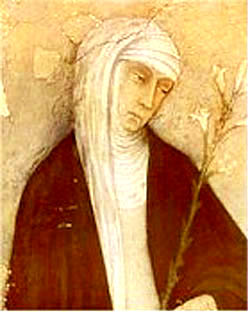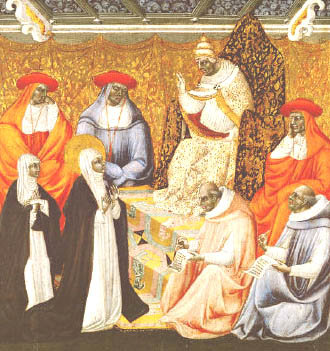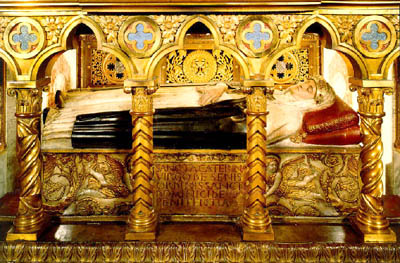 |
The Saint of the Day
St. Catherine of Siena (or Sena) – April 30
Prof. Plinio Corrêa de Oliveira
Biographical selection:
Catherine of Siena (1347-1380) was born March 25 in Siena, Italy, one of more than 20 children in a family of a wool dyer. When she was six-years-old, she began to have mystical revelations that continued throughout her life. She resisted the efforts of her parents to have her marry. Instead, when she was age 16, she became a third order Dominican. Her confessor and biographer was Blessed Raymond of Capua.
During the Avignon Captivity, She urged Pope Gregory XI to leave Avignon and return to Rome, which he did in 1377. She did not hesitate to reprove the next Pope, Urban VI, who welcomed her reprimands. She died on April 29, was canonized in 1461, and was declared Patron Saint of Italy in 1939.
Comments of Prof. Plinio:
St. Catherine of Siena was a layperson, and one of the greatest saints of the 14th century.

St. Catherine of Siena
Andrea di Vanni d'Andrea, Siena, Chiesa di San Domenico
|
She followed the orientation of Blessed Raymond of Capua, who wrote a very beautiful book about her life. We have, then, the history of a saint written by another saint; the history of a penitent written by her confessor. It is not very frequent one finds this. I read this biography written by Blessed Raymond of Capua and it is a true marvel.
In the late 14th century, the already bad situation of the Church became tragic. Before its end, the Middle Ages was spreading the virus of Humanism and Renaissance that would generate the monster of Protestantism.
In the Church there was no heresy, but there were all kinds of abuses by ecclesiastics. The Benedictine Order, which had been the pillar of the Church in Europe, was in a state of degeneration. The abbots took advantage of their positions and privileges to live like grand secular lords. Rather than providing their religious with the tranquility and stability that nourish detachment from worldly goods, such monasteries gave the opposite: a life of luxury that violated the Rule of St. Benedict. The Benedictine Rule requires pomp and richness for Divine Worship and the Church, but demands simplicity for the monks. In that time, however, abuses of earthly pleasures by monks abounded.
The secular [or diocesan] clergy was even more decadent than the regular clergy [priests and Bishops from religious orders]. The sickness extended to the very head of the Church: Cardinals and even the Pope. From it came a schism inside the Church. For a certain period, there were a Pope and two anti-popes creating such confusion that even saints were obeying anti-popes.
To make matters worse, the Popes were in Avignon, a French city that belonged to the Popes, but they were there under the dominion of the Kings of France. The good Catholics missed the Pope’s presence in Rome, which was so abandoned that often cattle could be found grazing inside the churches on the tall grass that had grown up there. This denotes the decadent situation of the center of Christendom.

St. Catherine of Siena persuades Gregory XI to leave Avignon and return to Rome - Paolo di Giovanni
|
It was in this epoch that Divine Providence called a laywoman, a semi-religious, who lived like a hermit inside the house of her father. She attracted followers who used to remain in conversation with her until late in the evening. She would discuss the events of the time with them and give them religious instruction. They became enthusiasts of St. Catherine. She was very intelligent and spoke easily and well. She understood how to treat these persons well, even while saying the difficult things they needed to hear.
She also maintained correspondence with several Popes, giving them orientation and transmitting to them the mystical revelations she had received regarding the future. She played a very important role in the affairs of her times. For example, she was chosen to be mediator in a controversy between the city of Florence and Pope Gregory XI. Later, she met the Pope at Avignon and urged him to return to Rome, which he did in 1377. She also strongly supported a crusade he convoked against the Turks. When the schism began under the reign of Urban VI, she publicly supported this Pope and often reprimanded him in private correspondence.
All this gave her a great fame and considerable influence on the Papacy. You understand, therefore, the good effect she exerted on Christendom at her time. She worked tirelessly for the reunification of the Church, and under her influence, Pope Gregory XI returned to Rome, a big step toward ending the general confusion.
Further, she was an amiable woman who loved to give gifts to her friends. She used to give them flowers and crosses, a very balanced combination. The flowers delighted them, and the crosses reminded them of the suffering they must bear to imitate Our Lord. She was also an enthusiast of indulgences, which she always encouraged her friends to acquire.
What is an indulgence? When a man commits a sin, there are two elements of it: the moral guilt and the corresponding penalty to be paid. The moral guilt for a sin is absolved by the pardon a priest gives in the sacraments of Penance or Extreme Unction. But the penalty still remains to be paid. When the priests were not liberal, they used to impose severe penances on their penitents. These penances greatly helped to remit the punishment due to sin. Today, with the increasingly less rigorous penances that confessors give, almost the entire penalty still remains to be paid.
Now then, an indulgence is a spiritual gift offered by the Church to partially or totally erase the punishment the person deserves. There are, for example, indulgences that free a soul from one year of punishment in Purgatory, others for three years, and even others – the plenary indulgences – that free a sinner from all the past penalties he would have to pay in Purgatory to be on a par with Divine Justice. So, you can understand the importance of indulgences.
In an epoch of faith, Catholics are eager to shorten their time in Purgatory as much as they can by means of indulgences. One reason the medieval people were enthusiasts of pilgrimages was because they went on them in the spirit of penance to shorten their time in Purgatory. They would travel to St. James of Compostella in Spain, to Rome, to the Holy Land, and to many particular places inside their own countries. During these travels, they were exposed to inconveniences, diseases and accidents, to being robbed or beaten by bandits, and even to death. They made those pilgrimages, however, with the principle aim of obtaining indulgences.

The tomb of St. Catherine under the altar in the Domenican Church, Santa Maria sopra Minerva in Rome
|
At Christmas, St. Catherine of Siena used to send a Papal Bull offering such and such indulgences along with her gifts to her friends. That is, what they could have earned by making a difficult pilgrimage, she gave them in a much simpler way as a special gift. This gave her friends great joy.
St. Catherine was also known for speaking the plain truth to people. When she gave her friends these indulgences, she was sending them an implicit message: “You have debts to pay. Do not forget them. Think about your death.” To give indulgences along with other Christmas gifts is a gracious way to speak this truth.
She also did not spare the truth with Cardinals and Popes, and they would accept her admonishments well. How different from today!
Today the clergy imagines itself above any criticism. They rarely accept any advice a layperson might offer them. Among many other things, Vatican Council II had this curious point. It did not say one word about the internal deterioration of the clergy, which was already terrible in the early ‘60s. Even today the clergy do not admit any lay person to speak about their defects, even though their sins and vices are exploding notoriously everywhere. If someone tries to give a counsel, they take it as an offense.
With this modern attitude of pride, you can understand the difference between the two crises. The crisis of the 14th and 15th centuries was a very grave one that prepared the way for Protestantism. But it is nothing in comparison to the crisis we are witnessing today. The difference is analogous to the gap between the first guns that appeared at that time and today’s atomic bomb. Both are weapons that cause death. But what a difference between an old harquebus and an atomic bomb! How small and insignificant is the effect of the first compared to the degree of destruction caused by the second!
What is this atomic bomb here? It is the spirit of the Revolution that penetrated the clergy and raised great pride in its members: they do not admit correction. Refusing to admit their faults, they fell deeper and deeper into them. As this cycle of vices repeated itself indefinitely, it produced the crisis we are witnessing today.
Since St. Catherine of Siena is a saint who worked to rebuild the Church at her time, it is natural that she should be the Patroness of those who work for the Catholic Church in the general collapse she experiences today. Therefore, let us ask her to help us achieve the victories she attained at her time. Protestantism would have come much sooner if St. Catherine of Siena would not had been faithful. We are much less than she was, but we should desire to do more than she did. We should desire and pray that the Revolution be destroyed, reduced to ruin, and that over its ruins the fortress-palace of the Reign of Mary be built. Let us ask her for this grace. I am sure that she will be pleased to hear this prayer and attend to it.


  | | Prof. Plinio Corrêa de Oliveira | |
The Saint of the Day features highlights from the lives of saints based on comments made by the late Prof. Plinio Corrêa de Oliveira. Following the example of St. John Bosco who used to make similar talks for the boys of his College, each evening it was Prof. Plinio’s custom to make a short commentary on the lives of the next day’s saint in a meeting for youth in order to encourage them in the practice of virtue and love for the Catholic Church. TIA thought that its readers could profit from these valuable commentaries.
The texts of both the biographical data and the comments come from personal notes taken by Atila S. Guimarães from 1964 to 1995. Given the fact that the source is a personal notebook, it is possible that at times the biographic notes transcribed here will not rigorously follow the original text read by Prof. Plinio. The commentaries have also been adapted and translated for TIA’s site.
|
Saint of the Day | Home | Books | CDs | Search | Contact Us | Donate

© 2002- Tradition in Action, Inc. All Rights Reserved
|
 |

|